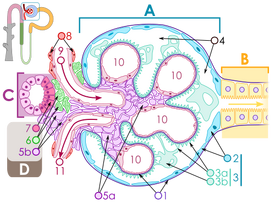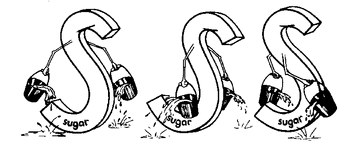
Renal threshold: When blood glucose rises over a certain level, it spills into the urine.

Renal corpuscle. Glomerulus capillaries are #10-the tubules are B and C.
In diabetic contexts, the renal threshold refers to the blood glucose level at which the kidneys begin to extract glucose from the blood and excrete it into the urine, causing glycosuria, or glucose in the urine.
Polyuria in diabetes shows that the body is unable to metabolize carbohydrates properly. Carbohydrates are turned into glucose, which is sent into the blood to feed the cells. The cells, lacking insulin, can't accept the glucose, so it remains in the blood causing hyperglycemia. The extra glucose in the blood accumulates there until the kidneys see it as an impurity to be filtered out and discarded. This point is known as the renal threshold.
When the renal threshold is exceeded, and the excess glucose begins to spill into the urinary tract, the glucose makes the urine attract water in what's known as the osmotic effect. This extra water in the urine causes the excessive urination, dehydrating the body, which in turn causes the excessive drinking of polydipsia.
Renal threshold values differ by species. While dogs and humans share the same renal threshold value of 180 mg/dl (10 mmol/L), the renal threshold of cats is 288 mg/dl (16 mmol/L); in cattle it's 108 mg/dl (6 mmol/L). [1]
Glucose is filtered through the glomeruli [2] in the kidney; for non-diabetics, all of the glucose is re-absorbed by the renal (kidney) tubules. This means there would be nothing present for a glucose urine test to detect. With hyperglycemia, the kidney tubules are unable to handle and process the amount of glucose they're being presented with, so the glucose winds up in the urine and can be detected in urine glucose testing. [3]
The excess of glucose in the urine is the cause of excessive urination, or polyuria. Both glucose and water are leaving the body; the loss of water is what causes polydipsia, or excessive drinking. This is a vicious circle known as osmosis.

Polyuria: Glucose cannot leave the body by itself--it must take water with it. Losing too much water means the body tries replacing it and this causes thirst, or polydipsia. When too much water is lost through excess urination and the excess drinking cannot make up for it, dehydration can occur.
Some vets use the renal threshold as an indicator of effective regulation -- with the reasoning that if glucose is not spilling into the urine, (easily tested using urine testing stix) the animal's blood sugar must be acceptable. This test is a good start, but this measurement is not particularly exact or reliable. Negative urine tests can tell you that the blood glucose level is under 180 mg/dl (10 mmol/L), but they can't indicate whether or not the blood glucose is too low and hypoglycemia is possible. It's also possible to get a negative glucose urine test at one point in the day and a high reading at another. This can indicate poor regulation or Somogyi rebound.
With regard to dogs, polydipsia and polyuria diabetic symptoms are not totally resolved, until he/she is kept below the renal threshold. [9] ![]()
References[]
- ↑ Taylor, Judith A. (2006). Harvesting the Gold-Urinalysis. District of Columbia Academy of Veterinary Medicine.
- ↑ Glomeruli. Wikipedia.
- ↑ Vetsulin-Diabetes Pathogenesis. Intervet.
- ↑ Basic Lab Information. Animal Emergency center of Milwaukee, WI..
- ↑ Vetsulin-Page 5. Intervet.
- ↑ Renal Threshold. Merck Veterinary Manual.
- ↑ Reference manual-Page 15-180mg/dl. Intervet.
- ↑ Blood Glucose Converter. Children With Diabetes.
- ↑ Fleeman, Linda, Rand, Jacqueline (2000). Long-Term Management of the Diabetic Dog-page 2. University of Queensland.